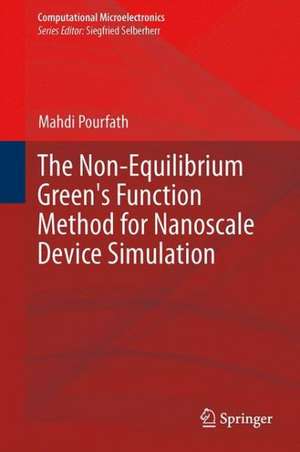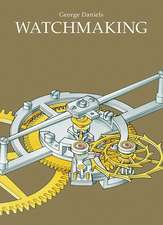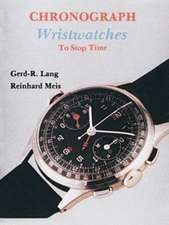The Non-Equilibrium Green's Function Method for Nanoscale Device Simulation: Computational Microelectronics
Autor Mahdi Pourfathen Limba Engleză Hardback – 25 iul 2014
In this book the required concepts from quantum and statistical mechanics and numerical methods for calculating Green functions are presented. The Green function is studied in detail for systems both under equilibrium and under nonequilibrium conditions. Because the formalism enables rigorous modeling of different scattering mechanisms in terms of self-energies, but an exact evaluation of self-energies for realistic systems is not possible, their approximation and inclusion in the quantum kinetic equations of the Green functions are elaborated. All the elements of the kinetic equations, which are the device Hamiltonian, contact self-energies and scattering self-energies, are examined and efficient methods for their evaluation are explained. Finally, the application of these methods to study novel electronic devices such as nanotubes, graphene, Si-nanowires and low-dimensional thermoelectric devices and photodetectors are discussed.
| Toate formatele și edițiile | Preț | Express |
|---|---|---|
| Paperback (1) | 725.75 lei 6-8 săpt. | |
| SPRINGER VIENNA – 23 aug 2016 | 725.75 lei 6-8 săpt. | |
| Hardback (1) | 742.69 lei 38-44 zile | |
| SPRINGER VIENNA – 25 iul 2014 | 742.69 lei 38-44 zile |
Din seria Computational Microelectronics
- 18%
 Preț: 944.51 lei
Preț: 944.51 lei - 20%
 Preț: 438.50 lei
Preț: 438.50 lei - 18%
 Preț: 954.45 lei
Preț: 954.45 lei - 15%
 Preț: 646.11 lei
Preț: 646.11 lei - 18%
 Preț: 951.91 lei
Preț: 951.91 lei - 18%
 Preț: 952.09 lei
Preț: 952.09 lei - 15%
 Preț: 638.11 lei
Preț: 638.11 lei - 15%
 Preț: 642.51 lei
Preț: 642.51 lei - 18%
 Preț: 954.45 lei
Preț: 954.45 lei -
 Preț: 390.08 lei
Preț: 390.08 lei -
 Preț: 386.99 lei
Preț: 386.99 lei -
 Preț: 397.38 lei
Preț: 397.38 lei - 20%
 Preț: 666.40 lei
Preț: 666.40 lei -
 Preț: 392.97 lei
Preț: 392.97 lei - 18%
 Preț: 1842.31 lei
Preț: 1842.31 lei - 15%
 Preț: 584.25 lei
Preț: 584.25 lei
Preț: 742.69 lei
Preț vechi: 977.21 lei
-24% Nou
Puncte Express: 1114
Preț estimativ în valută:
142.11€ • 154.85$ • 119.75£
142.11€ • 154.85$ • 119.75£
Carte tipărită la comandă
Livrare economică 19-25 aprilie
Preluare comenzi: 021 569.72.76
Specificații
ISBN-13: 9783709117996
ISBN-10: 3709117992
Pagini: 273
Ilustrații: XVII, 256 p. 78 illus., 31 illus. in color.
Dimensiuni: 155 x 235 x 22 mm
Greutate: 0.56 kg
Ediția:2014
Editura: SPRINGER VIENNA
Colecția Springer
Seria Computational Microelectronics
Locul publicării:Vienna, Austria
ISBN-10: 3709117992
Pagini: 273
Ilustrații: XVII, 256 p. 78 illus., 31 illus. in color.
Dimensiuni: 155 x 235 x 22 mm
Greutate: 0.56 kg
Ediția:2014
Editura: SPRINGER VIENNA
Colecția Springer
Seria Computational Microelectronics
Locul publicării:Vienna, Austria
Public țintă
ResearchCuprins
Review of quantum mechanics.- Review of statistical mechanics.- Green's function formalism.- Implementation.- Applications.- Non-interacting Green's functions.- Feynman diagrams.- Variational derivation of self-energies.
Textul de pe ultima copertă
For modeling the transport of carriers in nanoscale devices, a Green-function formalism is the most accurate approach. Due to the complexity of the formalism, one should have a deep understanding of the underlying principles and use smart approximations and numerical methods for solving the kinetic equations at a reasonable computational time.
In this book the required concepts from quantum and statistical mechanics and numerical methods for calculating Green functions are presented. The Green function is studied in detail for systems both under equilibrium and under nonequilibrium conditions. Because the formalism enables rigorous modeling of different scattering mechanisms in terms of self-energies, but an exact evaluation of self-energies for realistic systems is not possible, their approximation and inclusion in the quantum kinetic equations of the Green functions are elaborated. All the elements of the kinetic equations, which are the device Hamiltonian, contact self-energies, and scattering self-energies, are examined and efficient methods for their evaluation are explained. Finally, the application of these methods to study novel electronic devices such as nanotubes, graphene, Si-nanowires, and low-dimensional thermoelectric devices and photodetectors are discussed.
In this book the required concepts from quantum and statistical mechanics and numerical methods for calculating Green functions are presented. The Green function is studied in detail for systems both under equilibrium and under nonequilibrium conditions. Because the formalism enables rigorous modeling of different scattering mechanisms in terms of self-energies, but an exact evaluation of self-energies for realistic systems is not possible, their approximation and inclusion in the quantum kinetic equations of the Green functions are elaborated. All the elements of the kinetic equations, which are the device Hamiltonian, contact self-energies, and scattering self-energies, are examined and efficient methods for their evaluation are explained. Finally, the application of these methods to study novel electronic devices such as nanotubes, graphene, Si-nanowires, and low-dimensional thermoelectric devices and photodetectors are discussed.
Caracteristici
The Green's function for systems under equilibrium and non-equilibrium conditions are studied in detail Numerical methods for calculating Green's functions are presented Required concepts form quantum and statistical mechanics are presented Includes supplementary material: sn.pub/extras













